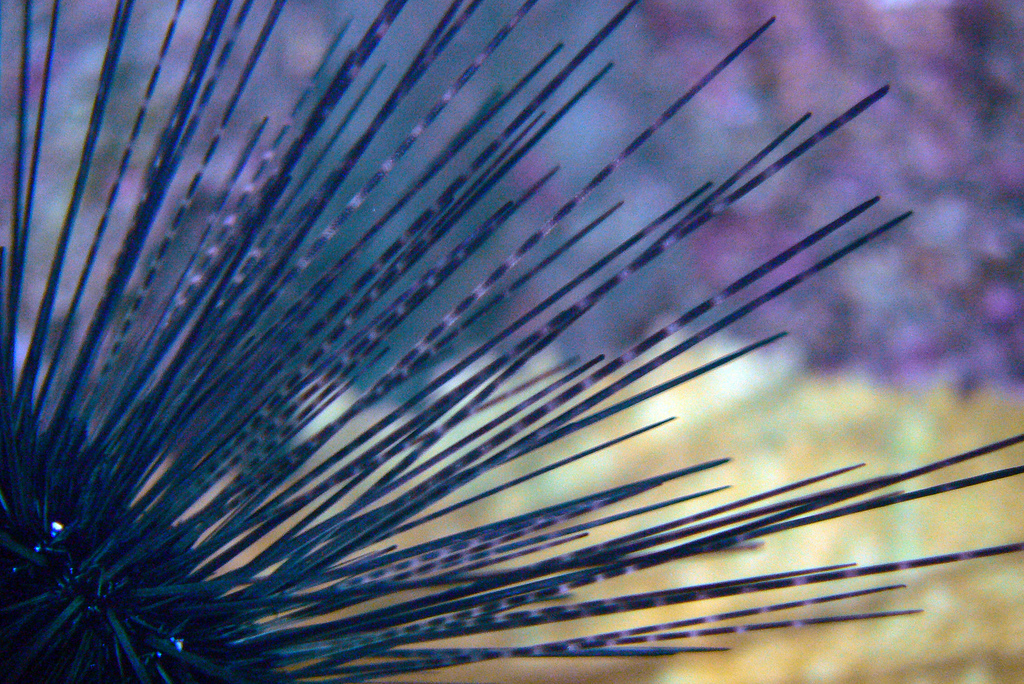We're open daily! View holiday hours
Science News
Urchin Smorgasbord
October 29, 2012

So much research on sea urchins lately… Why? What’s it all about? Luckily, we have an echinoderm expert here at the Academy, Rich Mooi, curator of Invertebrate Zoology and Geology. I brought several recent studies and headlines to him about these seemingly fragile yet durable sea creatures to make sense of it all. The article may be long, and just like a smorgasbord, be prepared to get stuffed, but it’s all so fascinating, delicious and worth it, you'll want to keep coming back for more!
“Urchins are good model systems for studying all kinds of evolutionary phenomena,” Rich explains, noting all of these recent stories about these amazing creatures. “Not only are they hardy and easy to raise in the lab, they have a wonderfully diverse and informative fossil record that allows us to talk about evolutionary events in real time.
“Besides, sea urchins are amazingly interesting animals, occupying a critical position in many ecosystems, including kelp forests off our Californian coasts and coral reefs around the world. With more than a thousand species of sea urchins, there is much to be learned.”
Urchin Sperm Navigation
Like how their sperm travel. I’m serious. Urchins don’t mate. Rich describes them as “broadcasters.”
“Males and females are separate, but each releases sperm and eggs (respectively) into the seawater. It is becoming apparent that certain species will aggregate so increase the chances that a sperm will meet up with an egg, but it is still a pretty iffy business. Eggs are small, and sperm even smaller, and they have to meet while they are still vigorous. It’s a big ocean...”
A recent study finds that these urchins have a tool to combat the vastness of the ocean—egg radar—or at least that’s how Rich explains it. “Essentially the sperm are detecting the eggs by sensing specific chemicals in the water and sampling the chemical trace often enough (like the frequent sweeps of a radar beam say, or perhaps even more like the constant sniffing of a bloodhound searching along the ground). The sperm sense gradients of the chemical traces and swim towards the highest concentrations.”
With any luck, finding a target within!
The next three items in today’s urchin buffet all have to do with the unusual structure and materials that make up these echinoderms.
Ocean Acidification
Last month, a group of scientists met in Monterey to discuss ocean acidification. It wasn’t all bad news—or at least not for sea urchins. Rich explains, “Unlike the shells of snails and clams, the skeleton of urchins (no one should call it a shell — the technical term is “test” to distinguish it from a shell) is internal: a product of pretty much the same internal growth mechanisms that produce vertebrate skeletons. We do not expect vertebrates to have problems with ocean acidification due to the rise in pH, so I don't expect the internal skeletons of echinoderms to have difficulties. The real problem? How easy will it be to get the calcium carbonate they use to make their skeleton from the sea water?”
Urchin Spine Strength
A new study in PLoS ONE finds the materials of an urchin’s spines to be incredibly strong but also very flexible. This odd combination of both elasticity and brittleness results from the spines' unique chemical composition, which allows them to absorb impacts and stress under some conditions—and to snap off under others.
“Each species has its own characteristic set of spines,” says Rich. “It is hard to imagine a hard substance like limestone to be flexible, but this is pretty much what happens when it is produced in the way that echinoderms can make it. I have been working on the distribution and systematics of a curious member of the same group discussed in the article, the ‘hair-spined urchin.’ Their whisker-thin spines are so flexible, they bend without breaking when you touch them, almost like hair.”
Urchin Elasticity of Collagen
Do urchins hold the key to the fountain of youth? No, but another study in PLoS ONE discusses the mutable collagenous tissues (MCT) in echinoderms. One headline about this study states, “What echinoderms can tell us about looking young.”
It’s not a new finding that echinoderms have this variable elasticity of collagen in their bodies, but the recent study highlights the “detection of the genes and proteins that are involved,” Rich says. “This is a long stretch from developing a skin cream!”
You can read more about MCT in these fascinating animals in Rich’s blog from last year’s Philippine Biodiversity Expedition.
Seconds, please
While you’re enjoying the banquet, Rich is busy with more urchin research. “There is the story of brooding Antarctic sea urchins, the new discoveries of deep-sea forms, and the stupendous urchin diversity in the Philippines... hard to know where to stop, or to imagine how I will manage to publish it all.”
Look for more urchin stories to come!
Image: catatronic/Flickr